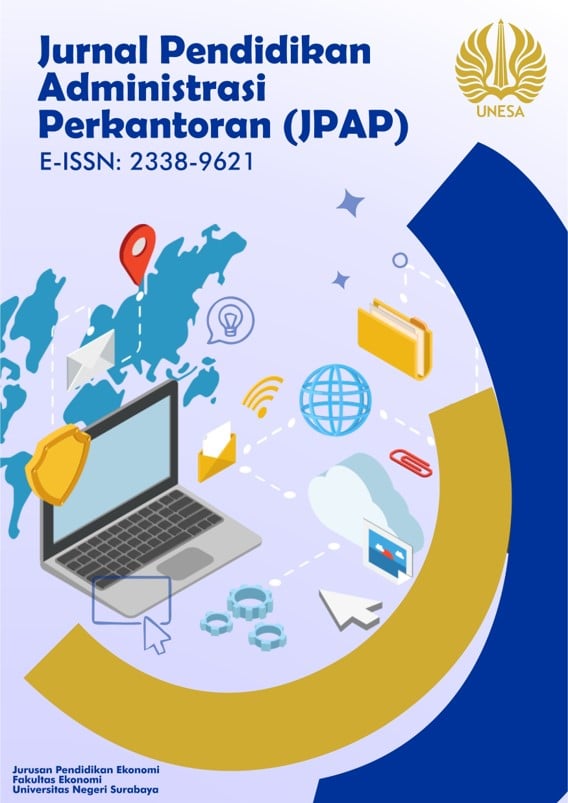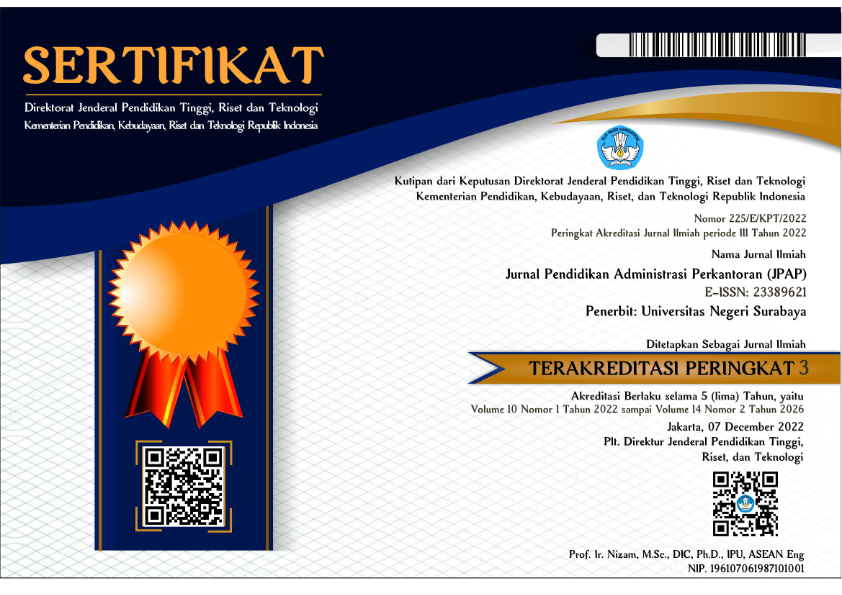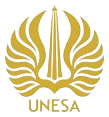Keefektifan SIMASKEREN Terhadap Penemuan Kembali Arsip di Dinas Perpustakaan dan Kearsipan Kota Blitar
DOI:
https://doi.org/10.26740/jpap.v8n2.p285-294Keywords:
Rediscovery of Archives Service, Simaskeren, Qualitative ApproachAbstract
Abstract
This study aims to describe the application of an electronic archive and archival management system (SIMASKEREN) in the Blitar City Regional Library and Archive Service, and to determine the effectiveness of the electronic archive and archival management system (SIMASKEREN) on the rediscovery of archives in the Blitar City Regional Library and Archives Service. The type of research used is descriptive research using a qualitative approach. The subjects of the research were employees at the Blitar City Regional Library and Archives Service who had worked for more than three years. Data collection techniques using interviews, observation, and documentation, while data analysis techniques include data reduction, presentation, and drawing conclusions and verification. From the results of the accuracy calculation done by researchers at the Blitar City Library and Archives Service, the Accuracy Number (AK) results are 0.4% where AK is recommended ranging from 0.5% to 3%, from these results it can be concluded that the SIMASKEREN in the office has not been effective against the rediscovery of archives in the Blitar City Library and Archives Service.
Keywords: Rediscovery of Archives Service; Simaskeren; Qualitative Approach
References
Abidin, S. S. Z. & Husin, M. H. (2018). Applied Computing and Informatics Prosiding Seminar Internasional A Malaysian Case Study", hlm. 010. School of Computer Sciences. University Sains Malaysia, Malaysia.
Gie, T. (2009). Administrasi Perkantoran Modern. Yogyakarta: Liberty.
Hamdi, A. & Bahruddin, E. (2015). Metode Penelitian Kuantitatif Aplikasi dalam Pendidikan. Yogyakarta: Deepublish.
Latif, F. & Pratama, A. W. (2015). Perancangan Sistem Informasi Manajemen Arsip Elektronik (E-Arsip) Berbasis Microsoft Access pada PT. Hi-Tst. Jurnal Akuntansi, Ekonomi dan Manajemen Bisnis, 3(1), 21-31.
Leboeuf, M. (2010). Memenangkan dan Memelihara Pelanggan Seumur Hidup. Jakarta: PT Tangga Pustaka.
Martono, B. (2012). Penyimpanan Berkas dalam Manajemen Kearsipan. Jakarta: Pustaka Sinar Harapan.
Milles, M. & Huberman, A. (2014). Qualitative Data Analysis, A Methods Sourcebook Edition 3. USA: Sage Publication.
Muhidin, S. A., Winata, H., & Santoso, B. (2016). Pengelolaan Arsip Digital. Pendidikan Bisnis & Manajemen, 2(3), 178-183.
Mustika, R., dkk. (2018). Pengelolaan Arsip di Detik Sumatera Selatan. Jurnal Iqra, 12(01), 83-98.
Nur N. S., Dhefi., & Sutarni, N. (2017). Penerapan Sistem Kearsipan Elektronik sebagai Determinan terhadap Produktivitas Kerja Pegawai. Jurnal Pendidikan Manajemen Perkantoran, 2(2), 148-156.
Ramanda, R. S. & Indrahti, S. (2015). Analisis Pengelolaan Arsip Inaktif terhadap Temu Kembali Arsip di Pusat Arsip (Record Center) Politeknik Negeri Semarang. Jurnal Ilmu Perpustakaan, 4(3), 211-220.
Rusdiwati & Ardoni. (2014). Sistem Penyimpanan dan Prosedur Temu Kembali Arsip Dinamis Aktif di Kantor Sekretariat DPRD Provinsi Sumatera Barat. Jurnal Ilmu Informasi Perpustakaan dan Kearsipan, 2(2), 22-32.
Setiawan, D. (2018). Dampak Perkembangan Teknologi Informasi dan Komunikasi terhadap Budaya. Jurnal SIMBOLIKA: Research and Learning in Communication Study, 4(1), 62-72.
Simamora, B. (2008). Riset Pemasaran. Jakarta: PT Gramedia Pustaka Utama.
Sugiyono. (2014). Metode Penelitian Bisnis. Bandung: Alfabeta.
Tagbotor, D. P., Adzido, R. Y. N., & Agbanu, P. G. (2015). Analysis of Records Management and Organizational Performance. International Journal of Academic Research in Accounting, Finance and Management Sciences, 5(2), 1-16.
Undang undang Republik Indonesia Nomor 43 Tahun 2009 tentang Kearsipan.
Wursanto. (2010). Kearsipan. Jakarta: Erlangga.
 Abstract views: 1042
,
Abstract views: 1042
, PDF Downloads: 1962
PDF Downloads: 1962










